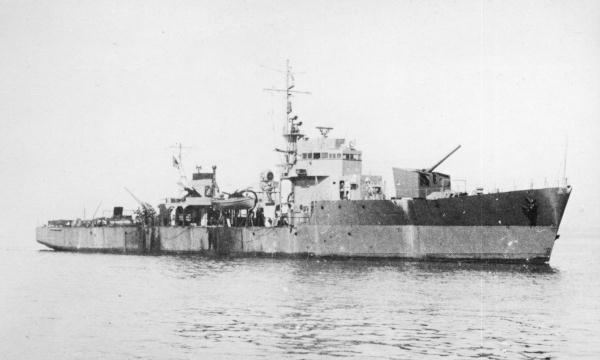Name No.1 class escort ship Cost 5,015,000 JPY | Built 1943–1946 | |
 | ||
Builders Maizuru Naval ArsenalKyōwa Zōsen CorporationMitsubishi Heavy IndustriesNaniwa Dock CompanyNihonkai Dock CompanyNihon Kōkan CorporationNiigata Iron Works | ||
The Type C escort ships (丙型海防艦, Hei-gata kaibōkan) were a class of ships in the service of the Imperial Japanese Navy during World War II. The Japanese called them "Type C" ocean defense ships, and they were the fifth class of Kaibōkan (Kai = sea, ocean, Bo = defense, Kan = ship), a name used to denote a multi-purpose vessel.
Contents
Background
The Type C, like the Ukuru-class and Mikura-class, were dedicated to the anti-aircraft and anti-submarine role.
On 22 April 1943, the Navy General Staff decided a mass production of escort ships, because of the urgent need to protect the convoys which were under constant attack. The plan was to build a basic escort ship of around 800 tons, with a simple design for easy construction. The first designs, for "Type A" Etorofu class and "Type B" Mikura class, still needed too many man-hours for building, so in June 1943, the Navy General Staff planned for a simplified design. The result was the Ukuru class, and a scaled-down model of the Mikura class, which became the "Type C" and "Type D" escort classes.
Design
Because of Japan's deteriorating war situation, the Type C was a further simplification of the Ukuru design. They were smaller by 200 tons and the Diesel engines that propelled them were also smaller, at 1900 SHP vs 4200 for the Ukurus. Because of the decrease in engine power, the speed fell from 19.5 knots to 16.5. The range remained the same, 6500 miles at 14 knots. The number of 4.7" guns went from three to two. The number of depth charges aboard was the same, 120, but the number of depth charge throwers was decreased from 18 to 12 and the depth charge chutes were decreased from two to one.
Due to the simplifications of the design, a significant saving was made in construction time. The Type C escorts required approximately 20,000 man-hours each, compared to the 35,000 man-hours of the Ukurus and the 57,000 man-hours of the Mikuras.
Construction
The design work of the Type C ships started in March, 1943, the same time as the Ukuru class. They were built concurrently with the Ukuru class and the Type D. The Type C class were given odd numbers, while the D Type were given even numbers. The Type C were constructed using prefabricated sections that enabled them to be built in as little as three to four months. The lead ship, No.1 (CD-1) was constructed at Mitsubishi, laid down on 15 September 1943, and completed with the No.3 (CD-3) on 29 February 1944.
Service
The C Type escorts were assigned to the Destroyer Divisions and Escort Divisions for convoy escort operations. However, by 1944 the advantage had passed to the US, and many C Type vessels became casualties as the Japanese merchant fleet was devastated by the American submarine offensive. There were 53 finished during the war of the 300 planned, and several completed after World War II ended. 26 were sunk during the war.
